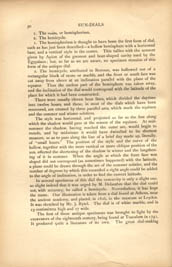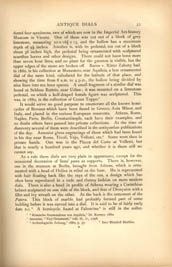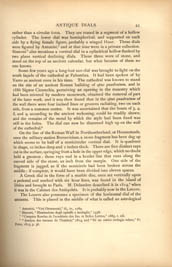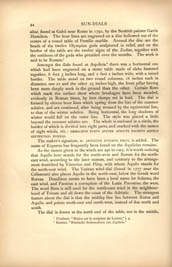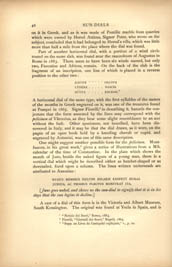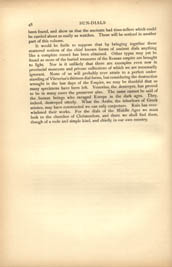CHAPTER II
ANTIQUE DIALS
| "Brutus. | Did Cicero say aught? |
| Casca. | Ay, he spoke Greek." |
| Julius Cæsar. |
EVERY writer on the horology of the ancients begins by quoting Vitruvius, who enumerates thirteen different kinds of dials, and gives the names of some of their inventors. Several specimens of these dials have been found during the last hundred and fifty years amongst the ruins of ancient buildings, though it is not yet possible to identify all that are mentioned by Vitruvius. Those types which are known can, however, be classified,1 and Professor Rayet, from whose admirably lucid paper we are tempted to quote largely, arranges them in three groups:
I. Spherical.
II. Conical.
III. Plane.
I. Spherical. — This is the simplest and most ancient form of all, the same that is mentioned by Alciphron, and it originated with the astronomical school which flourished on the shores of Asia Minor in the fourth century B.C. In the centre of a hollow hemisphere there was placed an upright rod, pointing to the zenith. As the sun rose above the horizon its rays touched the point of this rod, the shadow of which would, as the day wore on, trace, in a reverse course, the apparent movement of the sun. If the line followed by the shadow were then divided into twelve parts, the result would be a dial which marked the temporary hours of the day. If the same division were repeated at those seasons when the sun was at its highest, and the hour lines were then drawn through these divisions, the temporary or unequal hours for every day in the year would be ascertained.
The spherical dials may be subdivided into two classes:
1 Prof. G. Rayet, "Sur les cadrans coniques," "Annales de Chimie et de la Physique," 5ieme S., t. vi., 1875.
1. The σκάφη, or hemispherium.
2. The hemicycle.
1. The hemispherium is thought to have been the first form of dial, such as has just been described — a hollow hemisphere with a horizontal base, and a vertical style in the centre. This tallies with the account given by Apion of the gnomon and boat-shaped cavity used by the Egyptians; but, so far as we are aware, no specimen remains of this form of the antique dial.
2. The hemicycle, attributed to Berosus, was hollowed out of a rectangular block of stone or marble, and the front or south face was cut away from above at an inclination parallel with the plane of the equator. Thus the useless part of the hemisphere was taken away, and the inclination of the dial would correspond with the latitude of the place for which it had been constructed.
There were usually eleven hour lines, which divided the daytime into twelve hours, and these, in most of the dials which have been recovered, are crossed by three parallel arcs, which mark the equinox and the summer and winter solstices.
The style was horizontal, and projected as far as the line along which the shadow would pass at the season of the equinox. At midsummer the shadow, having reached the outer arc, would begin to recede, and by midwinter it would have dwindled to its shortest measure, so as to pass along the line of a brief day made up, literally, of "small hours." The position of the style and the curve of the hollow, together with the more vertical or more oblique position of the sun, effected the shortening of the shadow in winter and the lengthening of it in summer. When the angle at which the front face was sloped did not correspond (as sometimes happened) with the latitude, a plane could be drawn through the arc of the summer solstice, and the number of degrees by which this exceeded a right angle could be added to the angle of inclination, in order to find the correct latitude.
In several specimens of this dial the concavity is only a slight one, so slight indeed that it was urged by M. Delambre that the dial could not, with accuracy, be called a hemicycle. Nevertheless, it has kept the name. Our illustration is taken from a dial found at Athens, near the ancient academy, and placed, in 1826, in the museum at Leyden. It was sketched by Mr. J. Bytel. The dial is of white marble, and is 23 centimètres high and 27 wide.
The first of these antique specimens was brought to light by the excavators of the eighteenth century, being found at Tusculum in 1741. It produced quite a literature of its own. The great dial-making
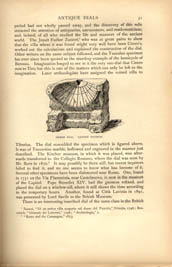
[Full Image]
GREEK DIAL. LEYDEN MUSEUM.
period had not wholly passed away, and the discovery of this relic attracted the attention of antiquaries, astronomers, and mathematicians, and, indeed, of all who studied the life and manners of the ancient world. The Jesuit Father Zuzzeri,1 who was at great pains to show that the villa where it was found might very well have been Cicero's, worked out the calculations and explained the construction of the dial. Other writers on the same subject followed, and the Tusculan specimen has ever since been quoted as the standing example of the hemicycle of Berosus. Imagination longed to see in it the very sun-dial that Cicero sent to Tiro, but this is one of the matters which can only be left to the imagination. Later archæologists have assigned the ruined villa to Tiberius. The dial resembled the specimen which is figured above. It was of Travertine marble, hollowed and engraved in the manner just described. The Kircher museum, in which it was placed, was afterwards transferred to the Collegio Romano, where the dial was seen by Mr. Burn in 1870.2 It may possibly be there still, but recent inquirers failed to find it, and no one seems to know what has become of it. Several other specimens have been disinterred near Rome. One, found in 1751 on the Via Flamminia, near Castelnuovo, is now in the museum of the Capitol. Pope Benedict XIV. had the gnomon refixed, and placed the dial on a window-sill, where it still shows the time according to the temporary hours. Another, found at Città Lavinia in 1891, was presented by Lord Savile to the British Museum.
There is an interesting inscribed dial of the same class in the British
1 Zuzzeri, "Di un antica villa scoperta sul dosso del Tuscolo," Venezia, 1746; Boscovich, "Giornale dei Letterati," 1746; "Archæologia," x.
2 "Rome and the Campagna," 1873.
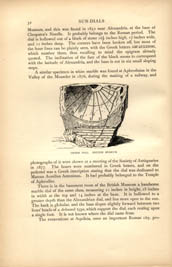
[Full Image]
GREEK DIAL. BRITISH MUSEUM.
Museum, and this was found in 1852 near Alexandria, at the base of Cleopatra's Needle. It probably belongs to the Roman period. The dial is hollowed out of a block of stone 16 ½ inches high, 17 inches wide, and 11 inches deep. The comers have been broken off, but most of the hour lines can be plainly seen, with the Greek letters ABΓΔEΣΖΗΘΙ, which number them, thus recalling to mind the epigram already quoted. The inclination of the face of the block seems to correspond with the latitude of Alexandria, and the base is cut in six small sloping steps.
A similar specimen in white marble was found at Aphrodisias in the Valley of the Meander in 1876, during the making of a railway, and photographs of it were shown at a meeting of the Society of Antiquaries in 1877. The hours were numbered in Greek letters, and on the pedestal was a Greek inscription stating that the dial was dedicated to Marcus Aurelius Antoninus. It had probably belonged to the Temple of Aphrodite.
There is in the basement room of the British Museum a handsome marble dial of the same class, measuring 21 inches in height, 18 inches in width at the top and 14 inches at the base. It is hollowed to a greater depth than the Alexandrian dial, and lies more open to the sun. The back is globular, and the base slopes slightly forward between two lions' heads of a debased type, which support the dial, each resting upon a single foot. It is not known where the dial came from.
The excavations at Aquileia, once an important Roman city, pro-
duced four specimens, two of which are now in the Imperial Art-history Museum in Vienna. One of these was cut out of a block of grey limestone, measuring 10 x 16 ½ x 15, and the hollow has a maximum depth of 9 ½ inches. Another is, with its pedestal, cut out of a block about 38 inches high, the pedestal being ornamented with sculptured acanthus leaves and other designs. There could not have been more than seven hour lines, and no place for the gnomon is visible, but the upper edges of the stone are broken off. Baron v. Ritter Zahony had, in 1880, in his collection at Monastero, near Aquileia, a less ornamented dial of the same kind, calculated for the latitude of that place, and showing the time from 8 a.m. to 4 p.m., the hollow being divided by nine lines into ten hour spaces. A small fragment of a similar dial was found at Schloss Buttrio, near Udine; it was mounted on a limestone pedestal, on which a half-draped female figure was sculptured. This was, in 1880, in the collection of Count Toppo.1
It would serve no good purpose to enumerate all the known hemicycles of Berosus which have been found in Greece, Asia Minor, and Italy, and placed in the various European museums. Athens, Rome, Naples, Paris, Berlin, Constantinople, each have their examples, and no doubt others have passed into private collections. At the time of discovery several of them were described in the antiquarian publications of the day. Antonini gives engravings of those which had been found in his day near Rome, Tivoli, Vejo, Velletri, etc.2 Some were then in private hands. One was in the Piazza del Corte at Velletri, but that is nearly a hundred years ago, and whether it is there still we cannot say.
As a rule these dials are very plain in appearance, except for the occasional decoration of lions' paws as supports. There is, however, one in the museum at Berlin, brought from Athens, which is ornamented with a head of Helios in relief on the base. He is represented with hair floating back like the rays of the sun, a design which has often been reproduced in a rude and clumsy fashion on more modern dials. There is also a head in profile of Athena wearing a Corinthian helmet sculptured on one side of the block, and that of Dionysios with a fillet and ivy wreath on the other. At the back is the ornament of the Patera. This block of marble had probably formed part of some building before it was carved into a dial. It is said to be of fairly early date B.C.3 A hemicycle found at Palestrina4 is still in the collec-
1 "Römische Sonnenuhren von Aquileia," Dr. Kenner, 1880.
2 Antonini, "Varj Ornamenti," vols, iii., iv., 1798.
3 "Archeologische Zeitung," 1880, p. 37.
4 Ince Blundell Marbles.
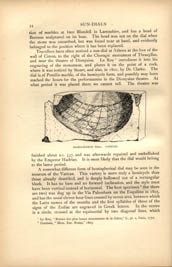
[Full Image]
GRÆCO-ROMAN DIAL. VATICAN.
tion of marbles at Ince Blundell in Lancashire, and has a head of Berosus sculptured on its base. The head was not on the dial when the stone was unearthed, but was found near at hand, and evidently belonged to the position where it has been replaced.
Travellers have often noticed a sun-dial at Athens at the foot of the wall of Cimon, to the right of the Choragic monument of Thrasyllus, and near the theatre of Dionysios. Le Roy1 introduces it into his engraving of the monument, and places it on the point of a rock, where it was noticed by Stuart, and also, in 1801, by Dr. Clarke. The dial is of Pentilic marble, of the hemicycle form, and possibly may have marked the hours for the performances in the Dionysian theatre. At what period it was placed there we cannot tell. The theatre was finished about B.C. 337, and was afterwards repaired and embellished by the Emperor Hadrian. It is most likely that the dial would belong to the latter period.
A somewhat different form of hemispherical dial may be seen in the museum of the Vatican. This variety is more truly a hemicycle than those already described, and is deeply hollowed out of a rectangular block. It has no base and no forward inclination, and the style must have been vertical instead of horizontal. The best specimen2 (for there are two) was dug up in the Via Palombara on the Esquiline in 1805, and has the usual eleven hour lines crossed by seven arcs, between which the Latin names of the months and the first syllables of those of the signs of the Zodiac are engraved in Greek letters. In the centre is a circle, crossed at the equinoctial by two diagonal lines, which
1 Le Roy, "Ruines des plus beaux monuments de la Grèce," ii, pl. 2, Paris, 1770.
2 Guattani, "Mem. Enc. Roma," 1805.
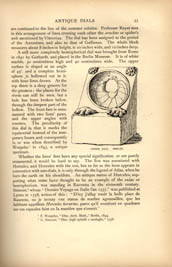
[Full Image]
GREEK DIAL. BERLIN.
are continued to the line of the summer solstice. Professor Rayet sees in this arrangement of lines crossing each other the arachne or spider's web mentioned by Vitruvius. The dial has been assigned to the period of the Antonines, and also to that of Gallienus. The whole block measures about 8 inches in height, is 20 inches wide, and 10 inches deep.
A still more completely hemispherical dial was brought from Rome in 1841 by Gerhardt, and placed in the Berlin Museum. It is of white marble, 50 centimètres high and 40 centimètres wide. The upper surface is sloped at an angle of 45°, and a complete hemisphere is hollowed out in it, with hour lines drawn. At the top there is a deep groove for the gnomon; the places for the rivets can still be seen, but a hole has been broken below, through the deepest part of the hollow. The front face is ornamented with two lions' paws, and the upper angles with rosettes. The peculiarity of this dial is, that it marks the equinoctial instead of the temporary hours, and consequently is, or was when described by Woepcke1 in 1843, a unique specimen.
Whether the lions' feet have any special signification, or are purely ornamental, it would be hard to say. The lion was associated with Hercules, and Hercules with the sun, but so far as the hero appears in connection with sun-dials, it is only through the legend of Atlas, when he bore the earth on his shoulders. An antique statue of Hercules, supporting what some have thought to be an example of the σκάφη or hemispherium, was standing in Ravenna in the sixteenth century. Simeoni,2 whose "Dernier Voyage en Italic l'an 1557,"was published at Lyons in 1558, writes of this: "D'icy j'allay voeir la belle place de Rauenne, ou je trouay vne statue de marbre agenouillée, que les habitans appellent Hercules horarius, parce qu'il soustient vn quadrant sur ces espaules faict en la manière que s'ensuit."
1 F. Woepcke, "Diss. Arch. Math.," Berlin, 1843.
2 G. Simeoni, "Illus. degli epitaffe e medaglie," 1558.
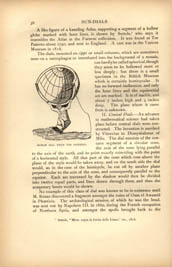
[Full Image]
ROMAN DIAL FROM TOR PATERNO.
A like figure of a kneeling Atlas, supporting a segment of a hollow globe marked with hour lines, is shown by Settele,1 who says it resembles the Atlas in the Farnese collection. It was found at Tor Paterno about 1790, and sent to England. A cast was in the Vatican Museum in 1816.
The dials, mounted on cippi or small columns, which are sometimes seen on a sarcophagus or introduced into the background of a mosaic, can hardly be called spherical, though they seem to be hollowed more or less deeply; but there is a small specimen in the British Museum which is certainly hemicycular. It has no forward inclination, and only the hour lines and the equinoctial arc are marked. It is of marble, and about 7 inches high and 4 inches deep. The place where it came from is unknown.
II. Conical Dials. — An advance in mathematical science had taken place before conical dials were constructed. The invention is ascribed by Vitruvius to Dionysiodorus of Milo. The dial consists of the concave segment of a circular cone, the axis of the cone lying parallel to the axis of the earth, and its point exactly coinciding with the point of a horizontal style. All that part of the cone which rose above the plane of the style would be taken away, and on the south side the dial would, as in the case of the hemicycle, be cut off by another plane perpendicular to the axis of the cone, and consequently parallel to the equator. Each arc traversed by the shadow would then be divided into twelve equal parts, and lines drawn through them, and thus the temporary hours would be shown.
No example of this class of dial was known to be in existence until M. Rénan discovered a fragment amongst the ruins of Oum el Awamid in Phœnicia. The archæological mission, of which he was the head, was sent out by Napoleon III. in 1860, during the French occupation of Northern Syria, and amongst the spoils brought back to the
1 Settele, "Mem. sopra la forma delle Linee," etc., 1816.
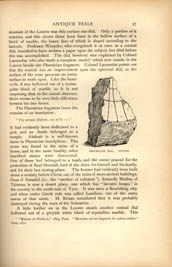
[Full Image]
PHŒNICIAN DIAL. LOUVRE.
museum of the Louvre was this curious sun-dial. Only a portion of it remains, and this shows three hour lines in the hollow surface of a block of marble, the lower face of which is sloped according to the latitude. Professor Woepcke, who recognized it at once as a conical dial, intended to have written a paper upon the subject, but died before this was accomplished. The dial, however, was explained by Colonel Laussedat, who also made a complete model,1 which now stands in the Louvre beside the Phœnician fragment. Colonel Laussedat points out that the conical was an improvement upon the spherical dial, as the surface of the cone presents an easier surface to work upon. Like the hemicycle, it was hollowed out of a rectangular block of marble, so it is not surprising that, to the casual observer, there seems to be very little difference betwixt the two forms.
The Phœnician fragment bears the remains of an inscription:
"Thy servant Abdosir, son of E—."
It had evidently been dedicated to a god, and no doubt belonged to a temple. Abdosir is a well-known name in Phœnician inscriptions. The stone was found in the ruins of a house, and in the same locality other inscribed stones were discovered. One of these had belonged to a tomb, and the owner prayed for the protection of Baal-Shemish, lord of the skies, for himself and his family, and for their last resting-place. The houses had evidently been built about a century before Christ, out of the ruins of more ancient buildings. Oum el Awamid (i.e, the "mother of columns"), formerly Medina el Taharan, is now a desert place, one which has "become heaps," in the country to the south-east of Tyre. It was once a flourishing city, and when under Greek rule was called Laodicea, one of the many towns of that name. M. Rénan considered that it was probably destroyed during the wars of the Seleucidæ.
A little further on in the Louvre stands another conical dial hollowed out of a greyish white block of crystalline marble. This
1 "Mission de Phénècie," 1864, Paris. "Memoire sur un fragment de cadran solaire." Paris, 1872.
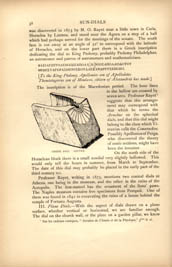
[Full Image]
GREEK DIAL. LOUVRE.
was discovered in 1873 by M. O. Rayet near a little town in Caria, Heraclea by Latmos, and stood near the Agora on a step of a hall which had perhaps served for the meetings of the senate. The south face is cut away at an angle of 52° to correspond with the latitude of Heraclea, and on the lower part there is a Greek inscription dedicating the dial to King Ptolemy, probably Ptolemy Philadelphus, an astronomer and patron of astronomers and mathematicians.
BAΣIΛEIΠTOΛEMAIΩIAΠOΛΛ[Ω]NIOΣAΠOΛΛOΔOTOϒ
ΘΕMIΣTAΓOPAΣMENIΣKOϒAΛΕΞANΔPEϒΣEΠOIEI.
[To the King Ptolemy, Apollonios son of Apollodotos Themistagoras son of Meniscos, citizen of Alexandria has made.]
The inscription is of the Macedonian period. The hour lines in the hollow are crossed by seven arcs. Professor Rayet1 suggests that this arrangement may correspond with that which he terms the Arachne on the spherical dials, and that this dial might belong to the class which Vitruvius calls the Conarachne. Possibly Apollonios of Perga, who discovered the theory of conic sections, might have been the inventor.
On the north side of the Heraclean block there is a small sun-dial very slightly hollowed. This would only tell the hours in summer, from March to September. The date of this dial may probably be placed in the early part of the third century B.C.
Professor Rayet, writing in 1875, mentions two conical dials at Athens, one being in the museum, and the other in the ruins of the Acropolis. The first-named has the ornament of the lions' paws. The Naples museum contains five specimens from Pompeii. One of them was found in 1842 in excavating the ruins of a house behind the temple of Fortuna Augusta.
III. Plane Dials. — With the aspect of dials drawn on a plane surface, whether vertical or horizontal, we are familiar enough. The dial on the church wall, or the plate on a garden pillar, we know
1 Sur les cadrans coniques, "Annales de Chimie et de la Physique," 3ième 8. vi.
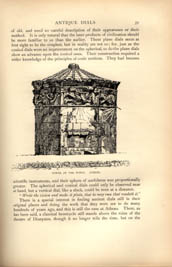
[Full Image]
TOWER OF THE WINDS. ATHENS.
of old, and need no careful description of their appearance or their method. It is only natural that the later products of civilization should be more familiar to us than the earlier. These plane dials seem at first sight to be the simplest, but in reality are not so; for, just as the conical dials were an improvement on the spherical, so do the plane dials show an advance upon the conical ones. Their construction required a wider knowledge of the principles of conic sections. They had become scientific instruments, and their sphere of usefulness was proportionally greater. The spherical and conical dials could only be observed near at hand, but a vertical dial, like a clock, could be seen at a distance.
"Write the vision and make it plain, that he may run that readeth it."
There is a special interest in finding ancient dials still in their original places and doing the work that they were set to do many hundreds of years ago, and this is still the case at Athens. There, as has been said, a classical hemicycle still stands above the ruins of the theatre of Dionysios, though it no longer tells the time, but on the
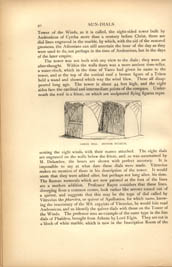
[Full Image]
GREEK DIAL. BRITISH MUSEUM.
Tower of the Winds, as it is called, the eight-sided tower built by Andronicus of Cyrrha more than a century before Christ, there are dial lines engraved in the marble, by which, with the aid of the restored gnomons, the Athenians can still ascertain the hour of the day as they were used to do, not perhaps in the time of Andronicus, but in the days of the later empire.
The tower was not built with any view to the dials; they were an after-thought. Within the walls there was a more ancient time-teller, a water-clock, which in the time of Varro had given its name to the tower, and at the top of the conical roof a bronze figure of a Triton held a wand and showed which way the wind blew. These all disappeared long ago. The tower is about 44 feet high, and the eight sides face the cardinal and intermediate points of the compass. Underneath the roof is a frieze, on which are sculptured flying figures representing the eight winds, with their names attached. The eight dials are engraved on the walls below the frieze, and, as was ascertained by M. Delambre, the hours are shown with perfect accuracy. It is impossible to say at what date these dials were made. Vitruvius makes no mention of them in his description of the tower. It would seem that they were added after, but perhaps not long after, his time. The Roman numerals which are now painted at the foot of the lines are a modern addition. Professor Rayet considers that these lines, diverging from a common centre, look rather like arrows tossed out of a quiver, and suggests that this may be the type of dial called by Vitruvius the pharetra, or quiver of Apollonios, for which name, knowing the inaccuracy of the MS. copyists of Vitruvius, he would fain read Andronicus, and so identify the quiver dials with those on the Tower of the Winds. The professor sees an example of the same type in the fine dials of Phaidros, brought from Athens by Lord Elgin. They are cut in a block of white marble, which is now in the Inscription Room of the
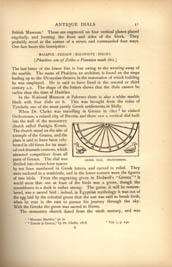
[Full Image]
GREEK DIAL. ORCHOMENES.
British Museum.1 These are engraved on four vertical planes placed angularly, and forming the front and sides of the block. They probably stood at the corner of a street, and commanded four ways. One face bears the inscription:
|
ΦAIΔPOΣ : ZΩIΛOϒ : ΠAIANIEϒΣ : EΠOIEI. [Phaidros son of Zoilos a Pæanian made this.] |
The last letter of the lower line is lost owing to the wearing away of the marble. The name of Phaidros, an architect, is found on the steps leading up to the Dionysian theatre, in the restoration of which building he was employed. He is said to have lived in the second or third century A.D. The shape of the letters shows that the dials cannot be earlier than the time of Hadrian.
In the National Museum at Palermo there is also a white marble block with four dials on it. This was brought from the ruins of Tyndaris, one of the most purely Greek settlements in Sicily.
When Dr. Clarke was travelling in Greece in 18012 he visited Orchomenes, a ruined city of Bœotia, and there saw a vertical dial built into the wall of the monastery church called Panágia Kemis. The church stood on the site of a temple of the Graces, and the place is said to have been celebrated in old times for its musical and dramatic contests, which attracted competitors from all parts of Greece. The dial was divided into eleven hour spaces by ten lines numbered in Greek letters, and carved in relief. They were enclosed in a semicircle, and in the lower corners were the figures of two birds. From the engraving given in Dodwell's "Greece"3 it would seem that one at least of the birds was a goose, though the resemblance to a duck is rather strong. The goose, it will be remembered, was a sacred bird; indeed, in Egyptian mythology it was out of the egg laid by the celestial goose that the sun was said to break forth, when he rose in the east to pursue his journey through the sky. With the Greeks the goose was sacred to Heres.
The monastery church dated from the ninth century, and was
1 "Museum Marbles," pt. ix.
2 "Travels in Greece," by Dr. Clarke, 1818.
3 Vol. i., p. 231.
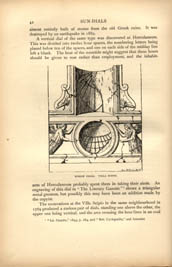
[Full Image]
ROMAN DIALS. VILLA SCIPIO.
almost entirely built of stones from the old Greek ruins. It was destroyed by an earthquake in 1889.
A vertical dial of the same type was discovered at Herculaneum. This was divided into twelve hour spaces, the numbering letters being placed below ten of the spaces, and one on each side of the midday line left a blank. The heat of the noontide might suggest that these hours should be given to rest rather than employment, and the inhabitants of Herculaneum probably spent them in taking their siesta. An engraving of this dial in "The Literary Gazette"1 shows a triangular metal gnomon, but possibly this may have been an addition made by the copyist.
The excavations at the Villa Scipio in the same neighbourhood in 1769 produced a curious pair of dials, standing one above the other, the upper one being vertical, and the arcs crossing the hour lines in an oval
1 "Lit. Gazette," 1843, p. 284, and "Brit. Cyclopædia," and Antonini.
rather than a circular form. They are traced in a segment of a hollow cylinder. The lower dial was hemispherical, and supported on each side by a flying female figure, probably a winged Hour. These dials were figured by Antonini,1 and at that time were in a private collection. Simeoni2 also mentions a vertical dial in a cylindrical hollow flanked by two plane vertical declining dials. These three were of stone, and stood on the top of an ancient calendar, but what became of them no one knows.
Some few years ago a long-lost sun-dial was brought to light on the south façade of the cathedral at Palestrina. It had been spoken of by Varro as ancient even in his time. The cathedral was known to stand on the site of an ancient Roman building of opus quadratum, and in 1886 Signor Cicercchia, perceiving an opening in the masonry which had been covered by modern stonework, obtained the removal of part of the later work, and it was then found that in the opus quadratum of the wall there were four incised lines or grooves radiating, two on each side, from a common centre. It was ascertained that the hours of 3, 4, 8, and 9, according to the ancient reckoning, could be readily shown, and the remains of the metal by which the style had been fixed was still in the holes. The dial can now be discerned high up on the wall of the cathedral.3
On the line of the Roman Wall in Northumberland, at Housesteads, once the military station Borcovicium, a stone fragment has been dug up which seems to be half of a semicircular vertical dial. It is quadrant in shape, 10 inches deep and 2 inches thick. There are five distinct rays cut in the surface, springing from a hole in the upper edge, which no doubt held a gnomon; these rays end in a border line that runs along the curved side of the stone, an inch from the margin. One side of the fragment is jagged, as if the semicircle had been broken across the middle; if complete, it would have been divided into eleven spaces.
A Greek dial in the form of a marble disc, once set vertically upon a pedestal and marked with six hour lines, was found in the island of Delos and brought to Paris. M. Delambre described it in 1814,4 when it was in the Cabinet des Antiquités. It is probably now in the Louvre.
The Louvre also possesses a specimen of the horizontal dial of the ancients. This is placed in the middle of what is called an astrological
1 Antonini, "Varj Ornamenti," iii., iv., 1789.
2 Simeoni, "Illustrazione degli epitaffe e medaglie," 1558.
3 "Comptes Rendus de l'académie des Ins. et Belles Lettres," 1885, t. xiii.
4 "Analyse des travaux de l'Institut," 1814, and "Di un antico orologio solare," Fr. Peter, 1815, p. 36.
altar, found at Gabii near Rome in 1792, by the Scottish painter Gavin Hamilton, The hour lines are engraved on a disc hollowed out of the centre of a round table of Pentilic marble. Around the disc are the heads of the twelve Olympian gods sculptured in relief, and on the border of the table are the twelve signs of the Zodiac, together with the emblems of the gods who presided over the months. The work is said to be Roman.1
Amongst the dials found at Aquileia,2 there was a horizontal one which had been engraved on a stone table made of slabs fastened together, 8 feet 3 inches long, and 2 feet 2 inches wide, with a raised border. The table stood on two round columns, 16 inches each in diameter, one 22 and the other 25 inches high, the front pillar having been more deeply sunk in the ground than the other. Certain flaws which mark the surface show where breakages have been mended, evidently in Roman times, by iron clamps set in lead. The dial is formed by eleven hour lines which spring from the line of the summer solstice, and are continued, after being crossed by the equinoctial line, to that of the winter solstice. Being horizontal, the long shadows of winter would fall on the outer line. The style was placed a little beyond the summer solstice arc. The whole is enclosed in a circle, the border of which is divided into eight parts, and marked with the names of eight winds, viz.: DESOLINVS EVRVS AVSTER AFRICVS FAONIVS AQVILO SEPTENTRIO BOREAS.
The maker's signature, M. ANTISTIVS EVPORVS FECIT, is added. The name of Euporus has frequently been found on the Aquileian remains.
As the names given to the winds are apt to vary, it is worth noticing that Aquilo here stands for the north-west and Boreas for the north-east wind, according to the later custom, and contrary to the arrangement described by Vitruvius and Pliny, with whom Aquilo stands for the north-east wind. The Vatican wind dial (found in 1777 near the Colisseum) also places Aquilo in the north-east, below the Greek word Boreas. Desolinus seems to have been a local name for Solanus, the east wind, and Faonius a corruption of the Latin Favonius, the west. The word Bora is still used for the north-east wind in the neighbourhood of Trieste and all down the coast of the Adriatic. The strangest feature about the dial is that the midday line lies between Eurus and Aquilo, and points south-east and north-west, instead of due north and south.
The dial is drawn at the north end of the table, not in the middle,
1 Froehner, "Notice sur la sculpture du Louvre," i. 9.
2 Kenner, "Römische Sonnenuhren von Aquileia."
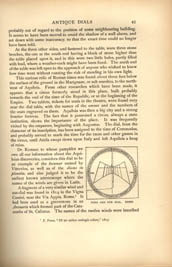
[Full Image]
WIND AND SUN DIAL. ROME.
probably out of regard to the position of some neighbouring building. It seems to have been moved to avoid the shadow of a wall above, and set down with some inaccuracy, so that the exact time could no longer have been told.
At the three other sides, and fastened to the table, were three stone benches, the one at the south end having a block of stone higher than the table placed upon it, and in this were two little holes, partly filled with lead, where a weather-cock might have been fixed. The north end of the table was left open to the approach of anyone who wished to know how time went without running the risk of standing in his own light.
This curious relic of Roman times was found about three feet below the surface of the ground in the Marignane, or salt marshes, to the northwest of Aquileia. From other researches which have been made, it appears that a circus formerly stood in this place, built probably towards the end of the time of the Republic, or at the beginning of the Empire. Two tablets, tickets for seats in the theatre, were found very near the dial table, with the names of the owner and the numbers of the seats engraved on them. Aquileia was then a big city and a strong frontier fortress. The fact that it possessed a circus, always a state institution, shows the importance of the place. It was frequently visited by the emperors, beginning with Augustus. The dial, from the character of its inscription, has been assigned to the time of Commodus, and probably served to mark the time for the races and other games in the circus, until Attila swept down upon Italy and left Aquileia a heap of ruins.
Dr. Kenner, to whose pamphlet we owe all our information about the Aquileian discoveries, considers this dial to be an example of the lacunar named by Vitruvius, as well as of the discus in planitia, and also judged it to be the earliest known amenoscope where the names of the winds are given in Latin.
A fragment of a very similar wind and sun-dial was found in 1814 in the Vigna Cassini, near the Via Appia, Rome.1 It had been used as a gravestone in an Arenaria which formed part of the Catacombs of St. Calixtus. The names of the twelve winds were inscribed
1 F. Peter, "Di un antica orologio solare," 1815.
on it in Greek, and as it was made of Pentilic marble from quarries which were owned by Herod Atticus, Signor Peter, who wrote on the subject, concluded that it had belonged to Herod's villa, which was little more than half a mile from the place where the dial was found.
Part of another horizontal dial, with a portion of a wind circle traced on the same slab, was found near the mausoleum of Augustus in Rome in 1883. There seem to have been six winds named, but only two, Favonius and Africus, remain. On the back of the slab is the fragment of an inscription, one line of which is placed in a reverse position to the other two:
| ɅↃO⅂Iᴚ | ..... | OSɅ⅂∀ᗡ |
| LVDERE | ..... | NESCIS |
| ID'OTA | ..... | RECEDE.1 |
A horizontal dial of the same type, with the first syllables of the names of the months in Greek engraved on it, was one of the treasures found at Pompei in 1865. Signor Fiorelli,2 in describing it, hazards the conjecture that the form assumed by the lines may correspond with the pelicinon of Vitruvius, as they bear some slight resemblance to an axe without the haft. Other specimens, not inscribed, have been discovered in Italy, and it may be that the dial drawn, as it were, on the pages of an open book held by a kneeling cherub or cupid, and engraved by Antonini, was one of this same description.
One might suggest another possible form for the pelicinon. Montfaucon, in his great work,3 gives a series of illustrations from a MS. calendar of the time of Constantine. In the plate which shows the month of June, beside the naked figure of a young man, there is a vertical dial which might be described either as hatchet-shaped or as dovetailed, fixed upon a column. The lines written underneath are attributed to Ausonius:
NUDUS MEMBRIS DELUNE SOLARIS RESPICIT HORAS
JUNIUS, AC PHŒBUS FLECTUS MONSTRAT ITA.
[June goes naked, and shows us the sun-dial to signify that it is in his days that the sun begins to decline.]
A cast of a dial of this form is in the Victoria and Albert Museum, South Kensington. The original was found at Yecla in Spain, and is
1 "Notizie dei Scavi," Roma, 1883.
2 Fiorelli, "Giornali dei Scavi," Napoli, 1865.
3 "Supp. au Livre de l'antiquité expliquée," v., p. 20.
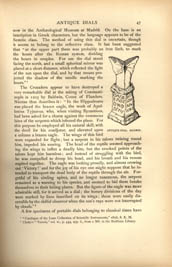
[Full Image]
ANTIQUE DIAL. MADRID.
now in the Archæological Museum at Madrid. On the base is an inscription in Greek characters, but the language appears to be of the Semitic class. The method of using this dial is uncertain, though it seems to belong to the reflective class. It has been suggested that "at the upper part there was probably an iron limb, to mark the hours after the Roman system, dividing the hours in couples. For use the dial stood facing the north, and a small spherical mirror was placed at a short distance, which reflected the light of the sun upon the dial, and by that means projected the shadow of the needle marking the hours."1
The Crusaders appear to have destroyed a very remarkable dial at the taking of Constantinople in 1205 by Baldwin, Count of Flanders. Nicetas thus describes it: "In the Hippodrome was placed the brazen eagle, the work of Apollonius Tyjaneus, who, when visiting Byzantium, had been asked for a charm against the venomous bites of the serpents which infested the place. For this purpose he employed all his natural skill, with the devil for his coadjutor, and elevated upon a column a brazen eagle. The wings of this bird were expanded for flight; but a serpent in his talons twining round him, impeded his soaring. The head of the reptile seemed approaching the wings to inflict a deadly bite, but the crooked points of the talons kept him harmless; and instead of struggling with the bird, he was compelled to droop his head, and his breath and his venom expired together. The eagle was looking proudly, and almost crowing out 'Victory!' and for the joy of his eye one might suppose that he intended to transport the dead body of the reptile through the air. Forgetful of his circling spires, and no longer venomous, the serpent remained as a warning to his species, and seemed to bid them betake themselves to their hiding places. But the figure of the eagle was more admirable still, for it served as a dial; the horary divisions of the day were marked by lines inscribed on its wings; these were easily discernible by the skilful observer when the sun's rays were not interrupted by clouds."2
A few specimens of portable dials belonging to classical times have
1 "Catalogue of the Loan Collection of Scientific Instruments," 1876, S. K. M.
2 Clarke's "Travels," vol. vi., p. 434, app. ii., from a MS. in the Bodleian Library.
been found, and show us that the ancients had time-tellers which could be carried about as easily as watches. These will be noticed in another part of this volume.
It would be futile to suppose that by bringing together these scattered notices of the chief known forms of ancient dials anything like a complete record has been obtained. Other types may yet be found as more of the buried treasures of the Roman empire are brought to light. Nor is it unlikely that there are examples even now in provincial museums and private collections of which we are necessarily ignorant. None of us will probably ever attain to a perfect understanding of Vitruvius's thirteen dial forms, but considering the destruction wrought in the last days of the Empire, we may be thankful that so many specimens have been left. Vesuvius, the destroyer, has proved to be in many cases the preserver also. The same cannot be said of the human beings who ravaged Europe in the dark ages. They, indeed, destroyed utterly. What the Arabs, the inheritors of Greek science, may have constructed we can only conjecture. Ruin has overwhelmed their works. For the dials of the Middle Ages we must look to the churches of Christendom, and there we shall find them, though of a rude and simple kind, and chiefly in our own country.

